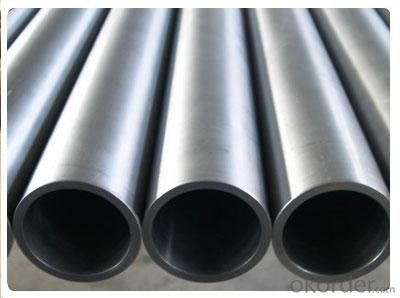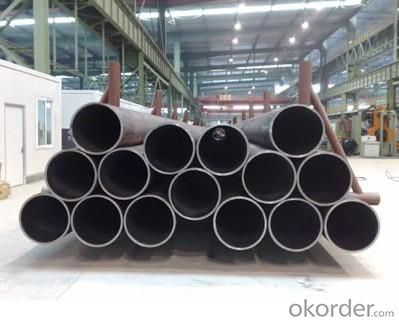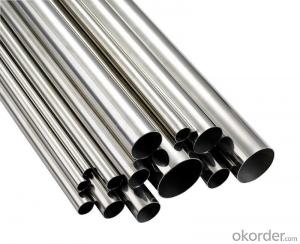Supply Best Quality 304 Stainless Steel Pipe
- Loading Port:
- Tianjin
- Payment Terms:
- TT or LC
- Min Order Qty:
- 25 m.t.
- Supply Capability:
- 10000 m.t./month
OKorder Service Pledge
OKorder Financial Service
You Might Also Like
We are company that have many years experience and professional manager team and engineer team and sales team, sure we will provide you high quality of pipe and professioanl service.
Seamless pipe possesses a hollow section and without seam around the strip steel. It is made with solid bar or steel ingot by perforating machine. As the facture process does not include any welding, seamless pipes are considered to be stronger and more durable. Generally speaking, seamless pipe has better pressure resistance and security than other classifications, and was usually more easily available than welded pipe.
2、Main Features of the Seamless Pipe:
• High working accuracy
• High strength
• Small inertia resistance
• Strong therming dissipine ability
• Good appearance
• Reasonble price
3、Seamless Pipe Specification:
Standard | GB, DIN, ASTM ASTM A106-2006, ASTM A53-2007 |
Grade | 10#-45#, 16Mn 10#, 20#, 45#, 16Mn |
Thickness | 8 - 33 mm |
Section Shape | Round |
Outer Diameter | 133 - 219 mm |
Place of Origin | Shandong, China (Mainland) |
Secondary Or Not | Non-secondary |
Application | Hydraulic Pipe |
Technique | Cold Drawn |
Certification | API |
Surface Treatment | factory state or painted black |
Special Pipe | API Pipe |
Alloy Or Not | Non-alloy |
Length | 5-12M |
Outer Diameter | 21.3-610mm |
Grade | 20#, 45#, Q345, API J55, API K55, API L80, API N80, API P110, A53B |
Standard | ASME, ASTM |
1) Material:20#(ASTM A 106/A53 GRB.API5LGRB,GB),45#,16Mn,10#.
2) Specification range: OD: 21.3-610mm, WT:6-70mm, length:6-12m or according to the requirement of clients.
3) Executive standards: GB, ASME API5L.ASTM A 106/A53,Despite of the above standards, we can also supply seamless steel pipe with standard of DIN, JIS, and so on, and also develop new products according to the requirements of our clients!
4) Surface: black lacquered, varnish coating or galvanized.
5) Ends: Beveled or square cut, plastic capped, painted.
6) Packing: bundles wrapped with strong steel strip, seaworthy packing.
4、Packaging & Delivery:
Packaging Details: | seaworthy package, bundles wrapped with strong steel strip |
Delivery Detail: | 15-30days after received 30%TT |
5、FAQ of Seamless Pipe:
①How is the quality of your products?
We have many years business experience in this area, and we have professional engineer and manager team and sure we can provide you high quality production and professional service.
②How about price?
Yes, we are factory and be able to give you lowest price below market one, and we have a policy that “ for saving time and absolutely honest business attitude, we quote as lowest as possible for any customer, and discount can be given according to quantity”,if you like bargain and factory price is not low enough as you think, just don’t waste your time.Please trust the quotation we would give you, it is professional one.
③Why should you chose us?
We can give you both.Additionally, we can also offer professional products inquiry, products knowledge train(for agents), smooth goods delivery, exellent customer solution proposals.Our service formula: good quality+good price+good service=customer’s trust
SGS test is available, customer inspection before shipping is welcome, third party inspection is no problem.
6、Seamless Pipe Images:


- Q:How do you prevent noise transmission in stainless steel pipes?
- There exist various effective techniques for preventing noise transmission in stainless steel pipes. 1. Insulation: An effective and commonly used method for preventing noise transmission involves insulating the stainless steel pipes. To absorb and dampen sound waves, insulation materials like mineral wool, fiberglass, or foam can be wrapped around the pipes. This helps in reducing the noise transmitted through the pipes. 2. Vibration isolation: Noise transmission can also be minimized by utilizing vibration isolation techniques. This method entails the installation of flexible connectors or rubber mounts between the pipe and its supports. These isolators absorb vibrations and prevent them from being transmitted as noise through the pipe. 3. Anti-vibration pads: Another approach to prevent noise transmission is the use of anti-vibration pads. These pads are placed beneath the pipe supports to absorb vibrations and prevent their transmission as noise. They act as a barrier between the pipe and its support, significantly reducing noise transmission. 4. Acoustic lagging: The technique of applying a noise-reducing material directly onto the surface of the stainless steel pipes is known as acoustic lagging. This material, often composed of mass-loaded vinyl or rubber, acts as a barrier to block the transmission of sound waves. It effectively reduces noise transmission and can be combined with insulation for improved results. 5. Proper pipe routing: Minimizing noise transmission can be achieved by ensuring proper pipe routing. Pipes should be installed in a manner that reduces contact or proximity to other structures or surfaces that can amplify noise. Additionally, avoiding sharp bends or angles in the pipe can help in reducing noise transmission. It is important to consider that the choice of method may vary based on the specific noise issue and environment. Seeking guidance from a professional acoustic consultant or engineer is recommended to determine the most suitable solution for a particular situation.
- Q:How do you join stainless steel pipes to other materials?
- There are various methods available for joining stainless steel pipes to other materials, depending on the specific application and requirements. Below are some commonly used techniques: 1. Welding: The most widely used and effective method for joining stainless steel pipes to other materials is welding. Depending on the material and desired joint strength, different welding processes like TIG welding, MIG welding, or stick welding can be employed. Welding ensures a strong and long-lasting bond between the stainless steel pipes and other materials. 2. Flanges: Flanges are frequently utilized to connect stainless steel pipes to other materials when easy disassembly or connection to different equipment is necessary. Flanges are usually made from materials such as carbon steel, cast iron, or even stainless steel itself. These flanges are bolted together, creating a secure joint that can be easily disconnected, as required. 3. Threaded connections: Threaded connections provide another means of joining stainless steel pipes to other materials. This method is commonly used for smaller diameter pipes or situations where easy removal or replacement of the pipes is needed. Threaded connections can be achieved using pipe fittings like couplings, unions, or adapters, which have male and female threads that screw together to form a tight seal. 4. Compression fittings: Compression fittings are an alternative option for joining stainless steel pipes to other materials. These fittings consist of a compression nut, a ferrule, and a body that houses the ferrule. The ferrule is compressed onto the pipe, creating a tight seal when the compression nut is tightened. Compression fittings ensure a reliable and leak-free joint between stainless steel pipes and other materials. 5. Mechanical connectors: In certain cases, mechanical connectors can be used to join stainless steel pipes to other materials. These connectors typically involve clamping or fastening mechanisms that secure the pipes together without the need for welding or threading. Mechanical connectors are suitable when disassembly and reassembly are required. When selecting the appropriate method to join stainless steel pipes to other materials, it is crucial to consider the specific application, material compatibility, and the required strength and durability of the joint. Consulting with a professional or referring to industry standards and guidelines is recommended to ensure a proper and reliable connection.
- Q:Are stainless steel pipelines buried in need of corrosion protection?
- Pipeline buried environment factors: underground laying requirements of 3, one is corrosion protection, two is elevation, slope, and three is density. If it is electrochemical reaction, the design should have technical instructions or preventive measures.
- Q:What are the common joining methods for stainless steel pipes?
- Stainless steel pipes can be joined using different methods, including welding, threaded connections, and flanged connections. Welding is the most commonly used method for joining stainless steel pipes. By melting the pipe ends and using a welding electrode, the pipes are fused together. Depending on the application's requirements, various welding techniques like TIG welding, MIG welding, or Stick welding can be employed. Threaded connections are another popular method, especially for smaller diameter pipes. This involves threading the ends of the pipes and using threaded fittings to connect them. Threaded connections are easy to install and disassemble, and they provide a secure and leak-proof joint. For larger diameter pipes or situations requiring easy disassembly and reassembly, flanged connections are used. This method involves attaching flanges to the pipe ends and connecting them using bolts and gaskets. Flanged connections offer a reliable and rigid joint, commonly used in industrial applications that require frequent maintenance or replacement. It is important to consider various factors such as pipe diameter, pressure and temperature requirements, accessibility, and the specific application when choosing a joining method for stainless steel pipes. Consulting with a qualified engineer or professional is recommended to ensure the most appropriate method is selected for a specific project.
- Q:What is the difference between stainless steel tube 304L and 304N?
- 304L is a variety of 304 stainless steel with low carbon content, used for occasions where welding is required.
- Q:What is lined with stainless steel?
- Stainless steel lining is a method of trenchless repair of underground pipes.
- Q:Can stainless steel pipes be used in the agriculture industry?
- Indeed, the agriculture industry can employ stainless steel pipes. As a remarkably sturdy and corrosion-resistant material, stainless steel proves ideal for diverse agricultural applications. For instance, stainless steel pipes find frequent use in agricultural fields for irrigation systems, water distribution networks, and drainage systems. Their resistance to rust, corrosion, and chemical harm guarantees a prolonged lifespan despite the harsh agricultural environment. Moreover, stainless steel pipes offer convenience in terms of cleaning and maintenance, rendering them a favored option for transporting an array of liquids and gases within the agriculture industry.
- Q:How do you calculate the pressure rating of stainless steel pipes?
- To calculate the pressure rating of stainless steel pipes, you need to consider several factors. First, you need to know the material properties of the stainless steel being used, such as its yield strength and tensile strength. These properties can be obtained from material data sheets or by conducting mechanical tests. Next, you need to determine the wall thickness of the stainless steel pipe. This can be measured directly or obtained from the pipe manufacturer's specifications. It is important to ensure that the wall thickness is uniform along the entire length of the pipe. Once you have the material properties and the wall thickness, you can use the appropriate formula or calculation method to determine the pressure rating. There are various codes and standards available that provide guidance on calculating pressure ratings for different types of pipes, such as the ASME B31.3 code for process piping or the ASME B31.1 code for power piping. These codes typically consider factors such as the allowable stress of the material, safety factors, and design considerations. The formulas or calculation methods provided in these codes take into account the material properties, wall thickness, pipe diameter, and other relevant parameters to calculate the maximum allowable pressure that the stainless steel pipe can withstand. It is important to note that the pressure rating of stainless steel pipes may also depend on other factors, such as the temperature of the fluid being transported, the corrosive nature of the fluid, and any potential external loads or stresses on the pipe. Therefore, it is recommended to consult the applicable codes, standards, or a qualified engineer to ensure accurate calculations and to consider all relevant factors when determining the pressure rating of stainless steel pipes.
- Q:Can stainless steel pipes be used for nuclear waste storage?
- Stainless steel pipes can indeed be used for nuclear waste storage. Stainless steel is highly resistant to corrosion, making it an ideal material for containing and transporting hazardous materials such as nuclear waste. The properties of stainless steel, including its durability, strength, and ability to withstand extreme temperatures, make it suitable for long-term storage of radioactive waste. Additionally, stainless steel is non-reactive and does not leach out harmful substances, ensuring the integrity of the stored waste. It is important, however, to ensure that the stainless steel used meets the specific requirements and standards set for nuclear waste storage to ensure maximum safety and containment.
- Q:Can stainless steel pipes be used for pulp and paper industries?
- Stainless steel pipes are indeed applicable for use in the pulp and paper sectors. Due to their remarkable resistance against corrosion and abrasion, these pipes are well-suited for the tough and corrosive environments commonly found in pulp and paper mills. They are capable of enduring the corrosive chemicals and high temperatures associated with the production process, ensuring the piping system's longevity and reliability. Moreover, stainless steel pipes possess exceptional mechanical properties, such as high tensile strength and resistance to stress corrosion cracking. These qualities are crucial for the efficient transportation of fluids and gases within the pulp and paper industry. Overall, stainless steel pipes provide a durable, hygienic, and cost-effective solution for fulfilling piping requirements in the pulp and paper sectors.
1. Manufacturer Overview |
|
|---|---|
| Location | |
| Year Established | |
| Annual Output Value | |
| Main Markets | |
| Company Certifications | |
2. Manufacturer Certificates |
|
|---|---|
| a) Certification Name | |
| Range | |
| Reference | |
| Validity Period | |
3. Manufacturer Capability |
|
|---|---|
| a)Trade Capacity | |
| Nearest Port | |
| Export Percentage | |
| No.of Employees in Trade Department | |
| Language Spoken: | |
| b)Factory Information | |
| Factory Size: | |
| No. of Production Lines | |
| Contract Manufacturing | |
| Product Price Range | |
Send your message to us
Supply Best Quality 304 Stainless Steel Pipe
- Loading Port:
- Tianjin
- Payment Terms:
- TT or LC
- Min Order Qty:
- 25 m.t.
- Supply Capability:
- 10000 m.t./month
OKorder Service Pledge
OKorder Financial Service
Similar products
New products
Hot products
Hot Searches
Related keywords




























